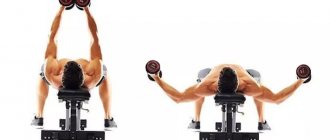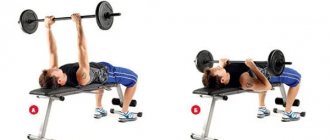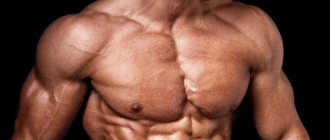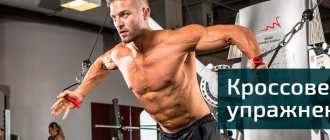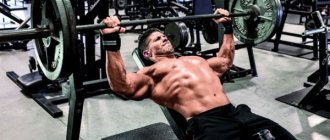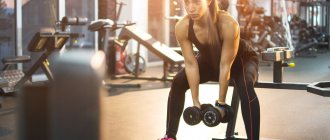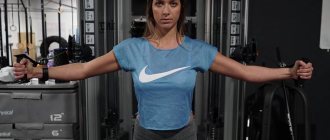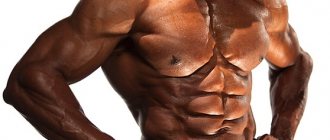Do exercises for girls to grow their pectoral muscles - this is the best way to slightly lift your breasts at home. They help get your “girls” back in shape and prevent sagging. In fact, with developed pectoral muscles, your posture will become better and your overall silhouette more attractive. Therefore, dear girls, away with tight bras with a push-up effect! Do this set of 15 exercises and in a couple of weeks you will already see the results.
Multi-joint exercises.
Bench presses
- Options: horizontal bench, positive incline bench, negative incline bench.
- Grip width: wide, regular, narrow.
- Equipment: barbell, dumbbells, in Smith.
Read also: Leg training for relief for women.
Bench press in Hummer
Push ups
- Execution options: from the floor, with your feet raised on the bench, hands resting on the bench, on one hand, with a clap.
- Hand width: wide (wider than shoulder width), normal (shoulder width), narrow.
- Equipment: bench, hand rests, Swiss ball, BOSU platform, medicine ball for narrow support with two hands, for support with one hand.
Push-ups on wide bars
- Execution options: with additional weight, with counterweight.
Isolation exercises.
Bringing hands together
- Execution options: on a horizontal bench, on a bench with a positive incline, on a bench with a negative incline.
- Equipment: dumbbells, crossover.
Reduction of hands in a standing crossover
- Execution options: from upper blocks, from lower blocks.
Pullover
- Execution options: lying on a bench, lying across the bench.
- Equipment: dumbbell, EZ barbell, cable trainer.
Reduction of arms in the Pec Deck simulator
Since the chest muscles are a large muscle group in the human body, they need to be worked through various exercises and a large number of hikes.
When creating a training program, choose 2-3 compound exercises and 1-2 isolation exercises to ensure maximum stimulation of muscle growth and strength gains.
Absolutely all exercises for the pectoral muscles involve them completely over their entire area, but still, each of these movements shifts the emphasis of the load to one or another area, depending on the angle of work.
To target the upper chest (sternal head), which is slightly larger than the clavicle and is the most visible part of this muscle in a woman, choose incline exercises.
Select exercises performed on a flat bench target overall chest muscle development, while exercises performed on a negative incline bench target the lower chest area.
As for working out the external and internal parts of the pectoral muscles, based on the rules of elementary biomechanics it follows that it is possible to pump up a separate part of a particular muscle only if this part performs a separate motor function. Therefore, it will not be possible to work these areas in detail; the load will be distributed over the entire plane.
Hormones responsible for female breast growth
There are only 15 hormones that regulate breast development in girls, the main ones are:
- estrogens (responsible for elasticity, do not allow the breasts to fall down)
- progesterone (responsible for the development of alveoli, the amount of glandular tissue, produced during puberty)
- prolactin (released during breastfeeding, responsible for the development of epithelial cells)
Active breast growth in girls begins at the age of 14-15 .
Hormones responsible for breast enlargement in girls
Sets and reps.
Generally speaking, the pectoral muscles of many women respond well to performing 10-15 repetitions and 2-3 working sets of a particular exercise. But this will all vary depending on your training history, current fitness level and goals.
Those women who want to focus their workouts on gaining muscle mass should work in the classic 8-10 rep range for 3-4 sets.
If you want to increase your strength, then a little more weight and training in the range of 6-10 repetitions in 3-4 approaches.
You can also include one, two or all three rep ranges in your training program for variety. For example, those looking to gain size and strength might alternate between training 8-12 reps one week and 6-10 reps the next.
The Most Powerful Chest Exercises
These chest exercises should be in every bodybuilder's arsenal.
I really like working out my chest muscles, because... These muscles are quite easy to feel and not so difficult to pump up if you understand some of the conditions that we will talk about below.
Due to the fact that the pectoral (pectoral) muscles are attached with the letter “L” to the sternum and collarbones, as we discussed above, we need to train them from different angles. The variety of exercises plays a major role here.
Bench press exercise on an incline bench
Perhaps the #1 exercise for building huge pectoral muscles.
As I said, the optimal slope would be about 20-30 degrees. It is not necessary to go higher, because Deltas will definitely come into play.
Very often, sports equipment manufacturers make a fixed bench angle of 45 degrees. This is very shitty, because... necessarily includes deltas in the work.
Therefore, I would advise taking a regular incline bench with the ability to change the angle of inclination and placing squat racks on the sides of it, putting a bar there and voila. The bench press we need is ready.
About the grip width. We take the barbell with a medium grip, because... this gives us a greater amplitude of movement, and accordingly complicates the work, and does not allow the triceps to engage in work.
We try to work within the amplitude (do not touch the chest with the bar and do not straighten the elbows completely at the top point), this will prevent the chest from switching off.
Next important point, put your feet up! You can bring yourself a footrest, for example. This will prevent you from arching over the bridge so that the load does not go into your legs, back, etc. you need to press without a bridge (straight back). You lose the opportunity to “cheat”.
Now about breathing.
There's nothing unusual here. Exhale as you push, inhale as you lower the barbell down.
As for the elbows, they need to be spread apart! This way you will focus on the pecs and not the triceps (when your elbows are parallel to your body, the triceps work).
I also recommend doing 6-12 reps. I generally work in the range of 6-10 repetitions. Although, if you are just starting out, then you can do even more repetitions, about 15-20. Select the weight so that muscle failure occurs in this rep range.
You don’t need to do any other barbell presses for now!
Let's structure a little information received about this type of bench press.
Technique:
- Lie down on the bench, remove the bridge, press your back tightly to the bench! You can also raise your legs up to isolate your pectoral muscles. This way you can lift less weight, but the load will go directly into the pectoral muscles, and will not be spread across the front deltoid, triceps and back.
- Take the bar of the bar slightly wider than your shoulders (at the lowest point your forearms should be parallel).
- After this, we lower the barbell down without touching the pectoral muscles at the lowest point! Feel your pecs stretch. At the same time, we draw air into our lungs.
- Now with a powerful movement, focusing on working the pectoral muscles, press the barbell up.
Important: do not straighten your elbows completely, so as not to remove the load from the pectoral muscles and not to direct it to the elbow joints.
- Now squeeze your pecs using a peak contraction.
Important: Imagine that your hands are up to your elbows from your shoulders, this is just a connecting link, and your hands end at your elbows. Push with your elbows, not your hands! This way you will focus the load on the pectoral muscles, removing it from the front deltoid and triceps.
Exercise dumbbell bench press on an incline bench
Incline Dumbbell Press – The next super effective exercise. We will be working on an incline bench!
The dumbbell press is much more difficult to perform than the barbell press, so, for example, if you bench press a 100 kg barbell for one rep, then you will not be able to bench press two dumbbells weighing 50 kg each.
When pressing dumbbells on a bench, there is no bar between the dumbbells, i.e. there is no additional stabilization that simplifies the work, so the body is forced to connect many stabilizer muscles, which are smaller in size and weaker in the generated force.
This is necessary in order to stabilize the movement of each hand individually.
Everything about the angle of the bench, the position of the elbows, etc. remains the same.
There will be two main differences:
- Dumbbell level at the lowest point.
- Method of lifting dumbbells to the starting position.
About the level of dumbbells at the lowest point. They will be slightly lower than with the barbell press, because... There is no “limiter” in the form of a neck in the middle. Therefore, we lower our arms down all the way, until the pectoral muscles are fully stretched.
The method of lifting dumbbells must be learned so as not to get very unpleasant injuries.
Just one disclaimer first: if you can't lift the dumbbells to the starting position on your own, then the weight is too heavy for you!
Technique:
- We take dumbbells in two hands and straighten the body (dumbbells on the sides).
- We rest the dumbbells just above the knees (on the front surface of the thigh), and smoothly sit down on the bench.
- With a powerful movement, we lean back, simultaneously pushing the dumbbells with our knees so that they are in the area of the shoulder girdle (dumbbells below).
- Remove the bridge, press your back tightly to the bench! You can also raise your legs up to isolate your pectoral muscles. This way you can lift less weight, but the load will go directly into the pectoral muscles, and will not be spread across the front deltoid, triceps and back.
- We spread our elbows to the sides (dumbbells parallel to the body), inhale lungs full of oxygen.
- After this, we press the dumbbells upward with a powerful movement, while exhaling air.
- Now squeeze your pecs using a peak contraction.
- Slowly lower the dumbbells down, feeling how the pectoral muscles contract at each point of the movement! At the same time, we draw air into our lungs.
Exercise guillotine press
A great exercise for developing chest muscles!
This is a variation of the bench press, except that the bar of the bar is lowered towards the throat.
But why lower the bar specifically to the throat? Does this look like some kind of inconvenient nonsense?
Yes, everyone thought so, until one scientist in the world of “smart bodybuilding” - Bret Contreras analyzed the electrical activity of most of our muscles during a variety of exercises using electromyography (EMG).
It turned out that if you shift the load vector from the chest a little higher to the throat, then almost the entire array of pectoral muscles begins to be involved in the work.
This was amazing and shocked most scientists and athletes at that moment!
- Starting position: Grab the barbell with a grip slightly wider than shoulder-width.
- Grip: You can use an open grip if you are an experienced athlete. For beginners, I advise using a closed grip.
- Remove the bridge, press your back tightly to the bench! You can additionally throw your legs up (as in the picture below) to isolate the pectoral muscles. This way you will be able to lift less weight, but the load will go directly into the pectoral muscles, and will not be spread over the legs, anterior deltoid, triceps and back.
- We begin to lower the barbell strictly vertically above our neck, and while lowering we take a deep breath.
- We lower the bar to a distance of 3-5 cm to our neck, feel the tension and stretching in our pecs, you can additionally linger in this position for 1 second.
- After this, with a powerful movement we squeeze the barbell up above our neck, while exhaling air. Important: do not straighten your elbows completely, so as not to remove the load from the pectoral muscles and not to direct it to the elbow joints.
- Now squeeze your pecs at the top using a peak contraction.
- Again, slowly lower the barbell down to the neck, feeling how the pectoral muscles contract at each point of the movement! At the same time, we draw air into our lungs.
- We perform the number of repetitions specified in our program.
Important: Imagine that your hands are up to your elbows from your shoulders, this is just a connecting link, and your hands end at your elbows. Push with your elbows, not your hands! This way you will focus the load on the pectoral muscles, removing it from the front deltoid and triceps.
Here's a visual of how it's done:
Also, to make it easier to remove the bridge in the back, to focus on the pectoral muscles, you can throw your legs on the bench:
Now, let’s move on to isolation exercises for the chest.
Dumbbell flyes lying on a bench
This exercise is isolating, i.e. It uses only one joint, which means you can work with much less weight than in presses or push-ups. It should be performed after basic basic exercises (presses and push-ups).
Very often people do not understand the fundamental difference between basic and isolation exercises. They say that basic exercises are “for mass”, and isolation exercises are “for form”. But this is not true!
You still work on a muscle for mass or for shape, it does not have a brain, it either contracts or lengthens due to some kind of load. And which one, it doesn’t matter to her either. That's not the point here.
An isolation exercise does not allow you to fully load the muscle and use significant weight, because Only one joint works, where there are a lot of weak links (ligaments, cartilage), so the progression of the load in such exercises is very problematic.
That's the whole secret. Basic exercises, due to the work of several joints, enable the body to distribute the load more evenly and make work more comfortable when working with heavy weights.
Technique:
- We take dumbbells in two hands and straighten the body (dumbbells on the sides).
- We rest the dumbbells just above the knees (on the front surface of the thigh), and smoothly sit down on the bench.
- With a powerful movement, we lean back, simultaneously pushing the dumbbells with our knees so that they are in the area of the shoulder girdle (dumbbells below).
- Remove the bridge, press your back tightly to the bench! You can also raise your legs up to isolate your pectoral muscles. This way you can lift less weight, but the load will go directly into the pectoral muscles, and will not be spread across the front deltoid, triceps and back.
- We hold dumbbells parallel to each other along our body. Then we squeeze them up.
- We spread our arms to the sides to the point of maximum chest stretch. Stretch your chest well.
- Then with a powerful movement, maintaining tension in the pectoral muscles, we bring our arms back to their original position.
Important: Think about your elbows as you would for bench presses. Imagine that you are hugging a large tree.
Tip: When your arms are almost brought together, slightly rotate your hands with the dumbbells inward (supination) towards your chest, this way you will further shorten them.
Raising and closing hands in a crossover
I love working in crossover. It makes it possible to do the exercise in a mode in which it is impossible to do it with dumbbells.
These are also isolation exercises.
As I said, our muscle fibers in the pectoral muscles are located under the letter “L”, which is why they need to be trained at different angles. In a crossover, you can achieve this rule perfectly by simply changing the height of the rollers on the struts.
I would even recommend, if possible, to perform fly-ups not with dumbbells, but in a crossover, because... this allows you to never stop working the pectoral muscles.
The weight on the crossover cables always pulls! Therefore, it is difficult for you to both raise your hands up and lower them down. This is difficult to achieve with dumbbells, because, as a rule, at the top point the arms with dumbbells relax.
You maintain tension at every point in the amplitude.
The angles can be very different:
- above;
- below;
- horizontal;
- intermediate;
Now I will not consider this breeding option in great detail, because the crossover has a lot of useful features and it deserves a separate article.
I suggest that you first try doing crossover flyes while lying on an incline bench.
The technique will be the same as when doing dumbbell flyes on an incline bench, you will just feel a constant tension in the pectoral muscles. The only difference is that you don’t have to throw the dumbbells up, but just take the handles in both hands.
It’s better to tell you more about the technique for bringing hands together in a standing crossover.
Technique:
- Take the handles in your hands. Stand exactly in the middle of the machine.
- Now walk forward a little with your arms outstretched until you feel a stretch in your pectoral muscles.
- You can keep your legs together, or slightly apart, but on the same line! There is no need to step forward with one foot, because... this creates torsional stress on the spine due to torque.
- Bring your arms together in front of you with a powerful movement. Using a peak contraction, additionally squeeze your pecs at the point of maximum tension.
- Now spread your arms back until the tension in your pectoral muscles remains. Stop at the point where the tension still remains and bring your hands together in front of you again.
Muscles trained with chest muscles.
The pectoral muscles are a fairly large muscle group, so many athletes dedicate a separate training day to working them.
Another option is to train your chest with your shoulders and triceps. This is a variation of the “Pull/Push” split where all pushing (pressing) movements involve the muscles of the chest, deltoids and triceps muscles.
In addition, the shoulders and triceps act as synergistic muscles in many chest exercises. This split option is suitable for those who want to save time in the gym and at the same time maintain a high workout intensity.
You can also work according to standard patterns - chest/triceps, chest/shoulders.
If you like the idea of devoting a separate day to chest training, but don't have time to do a 5-6 week split, train your chest muscles along with your biceps.
By combining these two biomechanically opposite muscle groups in one day, you can train them with greater intensity than in the chest/triceps or chest/shoulders variant.
Read also: Full – Body training program from Sarah Hunsberger.
The serratus anterior and teres major muscles can also be worked along with the pectoral muscles. They are included in the work in such exercises as: pullovers, dips, pull-ups on the horizontal bar.
In this case, the option of training the chest muscles with the back muscles is not excluded.
Correct "bodybuilding" technique
These tips are specifically for a bodybuilder, not a powerlifter. The main goal of bodybuilding is to increase muscle volume while maintaining an aesthetic physique.
Not overcoming maximum weight, but increasing muscle volume while maintaining ideal proportions! Do you feel the difference?
In order for muscles to grow, the load must increase, we talked about this at the very beginning of the article. But the load should increase not only bluntly due to the increase in weight on the apparatus, but also due to “switching off” the remaining muscles from work and complicating the work on the target group, i.e. breast.
Naturally, this way your weight on the bar will decrease, but the load will hit the target.
To complicate the work of our chest, the following conditions must be met:
- Partial range of motion is an excellent solution for bodybuilding because... allows you to keep your muscles in constant tension (no rest). Due to the reduction in amplitude, the weight on the bar will practically not fall. You can work at your previous working weight.
- The trajectory of the barbell movement – the barbell must move in an arc! Start at the bottom of the chest, and end at the top of the chest.
- Leg Position – A bodybuilder’s legs should be higher than a powerlifter’s. You can put them on a stand or move the bench to the row of dumbbells and put them there. This way, you remove the “bridge” (you don’t arch your back), thereby isolating the pectoral muscles even more. Plus, in this position, you do not help yourself with your legs, without involving other muscles in the work.
- Pectoral contraction at rest - you must learn to contract the pectoral muscles at rest, i.e. as if to “twitch” them. Focus on reducing them, so it will be easier for you to feel them while working in the gym.
- Grip width and position of the forearms - the grip width should be such that at the lowest point of the range of motion of the barbell, the forearms become parallel to each other. If you are working in partial amplitude, then the grip should be slightly wider than usual.
- Do not squeeze your shoulder blades together - this helps you squeeze out more weight, but takes the load off your chest. You will press more weight, but your chest will receive less load.
- The inclination of the bench - approximately 20-30 degrees upward from the horizontal - allows you to distribute the load more evenly across the entire chest.
- The number of approaches and repetitions is the classic repetition regime for a bodybuilder: 6-12. This applies to training fast muscle fibers. For slow ones, the range is slightly different (they focus on the failure time of 30-50 seconds). As a rule, approaches should not be done less than 4. After all, the chest is a large muscle group.
- An open grip is a grip where the thumb does not close the hands into a ring around the bar. This helps to better focus on contracting the pecs, but this grip is dangerous for beginners, so it is only suitable for more advanced athletes.
Frequency, duration and intensity of training.
Again, since the chest is a large muscle group, the best option is to train it with small groups or on a separate training day.
It's definitely not a good idea to combine chest and leg training on the same day if you want to work these two large muscle masses at high intensity and volume. You simply don’t have enough strength and energy for a full training session.
In terms of duration, training the pectoral muscles, if they are worked on one day, takes on average 30-45 minutes, if paired with other muscle groups - 45-60 minutes.
It's fairly easy to maintain intensity during a workout. The chest muscles are easily fatigued by using various methods of shocking the muscles - complex sets, drop sets, rest pauses, partial repetitions, negative repetitions.
Be sure to train with absolute failure on the last two sets, and the first two sets should be heavy enough to keep the training intensity high.
How the shape of the mammary glands is corrected
Correcting the shape of the mammary glands through physical exercise is possible due to the properties of the muscle fibers that surround the breasts. During training aimed at improving breast shape, muscle fibers are torn, forming microtraumas.
After a certain time, such injuries heal, forming new protein muscle compounds called myofibrils. At the same time, the new muscles are larger and have a different shape. This occurs due to the active synthesis of protein compounds, which must exceed their breakdown.
This effect is called supercompensation. Its essence is that the newly formed fibers not only restore the previous muscle volume, but also exceed it.
The most effective way to train the pectoral muscles for a girl is to go to the gym
There is also another point of view, according to which the change in breast shape occurs not due to an increase in the volume of fibers, but due to an increase in the number of muscle tissue cells. At the moment there is no single proven opinion, but most athletes and coaches are inclined to the first option.
However, in order for the breast shape to be corrected, followers of both theories are convinced that in addition to doing exercises, it is necessary to eat properly and follow training regimens, alternating them with rest. Because growth and adjustment of muscle mass occurs during the rest period.
Gaining muscle mass.
The chest is the most difficult muscle in a woman's body as you are most strong in the lower part of the body, so you have to work hard to create size and increase the strength of the pectoral muscles.
This can be done by training at high intensity, shocking the muscles with various exercises, and using fairly heavy weights week after week.
Be sure to include bench presses with a barbell or dumbbells in your program. This exercise, like no other, is aimed at increasing muscle mass in the pectoral muscles.
Just make sure you perform it with proper form and have the help of a training partner if you decide to do a couple of forced reps.
Comparison table of the best chest exercisers
| Name | Main characteristics | Price |
| Expander “Eight” | There are 3 load levels, the maximum resistance force is 5.5 kg. | ₽ 230 |
| "Athlete" | The maximum load is 30 kg, it is made of carbon steel and equipped with rubberized handles. | ₽ 490 |
| “Shayke Waite” | Works only during shaking, diameter - 8 cm, weight - 700 g. | ₽ 1350 |
| Bradex IMPULSE Ems Pro | There are 4 thin plastic gel pads, several operating modes, and runs on 2 AAA alkaline batteries. | ₽ 665 |
| Easy Curves | Weight - approximately 400 g, rubber handles. | ₽ 1990 |
Variety of exercises.
There are a few basic basic exercises that target the chest muscles, and there are tons of variations on these basics, so you should never get bored in your workouts or have your routine become "stale."
By changing bench angles, grip widths, or the type of equipment you use, you can customize your workout in new ways to keep your program fun, intense, and effective.
Varying your exercises will not only add variety to your gym routine and prevent plateaus; this is important for the full development of the pectoral muscles.
If you only stick to incline presses, your lower chest area will remain underdeveloped, which can cause an overall size imbalance.
Add variety to your program by choosing incline, horizontal, and negative presses every 2-3 workouts. Perform them in different orders to fully highlight the target chest area in each session.
Recommendations for girls on training
In order to carry out training to correct the shape of the pectoral muscles and glands as effectively as possible, you need to follow the following recommendations:
- You cannot start training exercises without warming up. Therefore, before the main exercises, it is worth performing several simple ones, for example, turns or tilts of the head and torso. You can also take about 10-15 minutes. run on an elliptical or treadmill to prepare your body.
- Complex exercises that require a lot of energy, such as the bench press, should be performed at the beginning of the workout, while you have the strength.
- When performing the bench press exercise, you must correctly set the height at which the bar will be located. It is advisable to position it so that during capture the arms are bent, forming an angle of 20°. This is necessary so that when you grab it and prepare for the exercise, there are no difficulties in removing it.
- The bar should be grasped with an overhand grip, and the hands should be kept at such a width that the index finger is located on the inside of the extreme mark. This distance is usually wider than a woman's shoulders.
- When lifting the barbell, your arms should move slightly diagonally. When the bar is lowered, the bar is located opposite the eyes, and when raised up, it is between the chest and neck.
- It is better to start each workout with a training set with a lower weight than usual. The number of repetitions is 15 pieces. You need to gradually increase the weight of the forestay with each approach until it reaches the working value.
By following all the rules and recommendations for training aimed at maintaining the tone of the pectoral muscles in the gym, you can not only significantly improve the appearance of your breasts, but also maintain good physical shape and health.
Symmetry.
If there is no development of the chest muscles, this will be clearly visible, especially with a small breast size.
If any area of the pectoral muscles is “lagging behind”, adjust the training according to this error.
With proper development, you get the same one. This can be helped by raising your arms with dumbbells on a bench at different angles and peak muscle contraction at the top of the range of motion.
Typical mistakes that lead to deterioration of breast condition
The transformation of beautiful and elastic breasts into sagging ones is provoked by:
- a sharp decrease or increase in body weight;
- an incorrectly selected bra: a small one leads to disruption of the blood circulation process, a large one provokes stretching of the skin;
- habit of hunching;
Important! When a girl tries to straighten her back and straighten her shoulders, her chest muscles involuntarily tense.
- exposure to ultraviolet radiation negatively affects the skin of the breast, drying it out.
We also recommend studying this topic:
How to properly pump up your pectoral muscles: a technique from professionals
15231 0 0
This material will be perfectly complemented by the following publications:
- How to pump up your chest on the uneven bars: a set of effective techniques
- Chest training program: split programs from professionals
Insulation.
To minimize the stress on your back and shoulders when performing bench presses, follow a few rules: the bar or dumbbells should not move in your hands, make sure to maintain a natural arch in the lower back, the bar is lowered to the top of your chest (incline press), the shoulder blades are brought together, the legs are firmly fixed with the heels on the floor, at the lowest point of the amplitude of movement the forearms should be vertical.
Exercises such as dumbbell flyes, crossovers, and Pec Deck exercises provide complete isolation work for the pectoral muscles, regardless of the angle of inclination. While performing these exercises, always maintain a slight bend in your elbow joint.
To maximize peak contraction, stop the movement in the positive phase of the repetition and tense your muscles hard for 1-2 seconds while the dumbbells or cable handles are 7-10cm apart.
Read also: How to pump up a woman’s arms: training program.
How to quickly pump up your pectoral muscles. Weekly training programs
Training the pectoral muscles in the gym allows you to correct the pectoral muscles in a short time. However, this may require different programs that involve burning fat, building muscle, or losing weight. Also, the training can be combined, which includes different types of exercises.
Active fat burning
The fat burning training program consists of 3 sets of exercises, which include:
| Day of the week | Exercise name | Number of repetitions | Number of approaches |
| Monday | Bent over dumbbell press | 10 | 4 |
| Smith bench press | 10 | 4 | |
| Seated dumbbell press | 12 | 3 | |
| Reverse row in the simulator | 12 | 3 | |
| Wednesday | Reverse flyes in the simulator | 10 | 4 |
| Extension of arms in the simulator from behind the head | 10 | 3 | |
| Crossover | 12 | 3 | |
| Dumbbell lateral raises | 12 | 3 | |
| Friday | Dumbbell bench press | 10 | 4 |
| Bench press (French) | 8 | 3 | |
| Upside down bench press | 12 | 4 | |
| Arm extensions | 15 | 3 |
Increased muscle mass
It is recommended to perform exercises to increase muscle mass less intensely than to lose weight, repeated 6 to 8 times within 3-5 approaches.
| Day of the week | Exercise name | Number of repetitions | Number of approaches |
| Monday | Seated Dumbbell Flyes | 6 | 3 |
| Dumbbell bench press | 6 | 5 | |
| Standing Dumbbell Raise | 8 | 5 | |
| Push-ups in the simulator | 7 | 5 | |
| Wednesday | Smith Incline Press | 6 | 4 |
| Seated dumbbell raises | 6 | 4 | |
| Dumbbell Incline Press | 8 | 4 | |
| Barbell curls | 6 | 3 | |
| Friday | Weighted press | 8 | 4 |
| Overhead extensions | 8 | 5 | |
| Push press on the machine | 6 | 3 | |
| Inclined information on the block | 8 | 3 |
Weight loss
Workouts for weight loss should include exercises that strike a balance between losing fat and building muscle. Well suited for beginners and inexperienced athletes.
| Day of the week | Exercise name | Number of repetitions | Number of approaches |
| Monday | Bench press | 12 | 3 |
| Chest bars | 12 | 3 | |
| Scott Barbell Lift | 12 | 3 | |
| Barbell curl | 10 | 3 | |
| Wednesday | Seated dumbbell press | 12 | 3 |
| Dumbbell lateral raises in a lying position | 12 | 2 | |
| Romanian deadlift | 12 | 3 | |
| Dumbbell lateral raises | 12 | 3 | |
| Friday | Bent-over barbell row | 12 | 3 |
| Pullover | 12 | 4 | |
| Extension of arms and upper block | 12 | 3 | |
| Reverse row in a seated position | 12 | 3 |
Combined training
Combined training is aimed at maintaining general tone and includes elements of strength and cardio exercises.
| Day of the week | Exercise name | Number of repetitions | Number of approaches |
| Monday | Bench press | 6 | 3 |
| Seated dumbbell press | 8 | 3 | |
| Pushups | 12 | 3 | |
| Dumbbell lateral raises | 12 | 3 | |
| Wednesday | Seated barbell press | 4 | 3 |
| Dumbbell bench press | 8 | 3 | |
| Pushups | 12 | 3 | |
| Dumbbell flyes in a lying position | 8 | 3 | |
| Friday | Dips | 12 | 3 |
| Downward Angle Barbell Press | 4 | 3 | |
| Bench press | 6 | 3 | |
| Dumbbell bench press | 12 | 3 |
Priority.
If your pectoral muscles are lagging behind in development relative to the rest of your body, you can apply the principle of priority to your training program by starting your training week by working these muscles.
Also try to train your chest once a week only with presses (barbell, dumbbells) at different bench angles (positive, negative, horizontal) and no isolation exercises.
Another way to prioritize development is to train your chest by doing a heavy workout one week, followed by an intense workout that includes isolation movements the second week.
Strength exercises build strength and mass, while isolation exercises help build muscle.
The main exercise for building the pectoral muscles is the bench press. If you don't include it in your program, it could be the cause of underdeveloped pectoral muscles!
By all means include presses in your routine, but make sure you are using proper form to perform the movement.
How to enlarge a girl's breasts without surgery?
There are many ways to enlarge a girl’s breasts without surgery. And it is not at all necessary to go under the knife of a plastic surgeon. Regularly taking care of your bust at home helps maintain its shape.
Home remedies to prevent age-related breast sagging include:
- Compresses. Decoctions of nettle and birch bark, supplemented with essential oils of ylang-ylang, lemon, patchouli, eucalyptus, not only help tighten muscles, but also eliminate stretch marks on the skin. All you need is to take medical gauze, fold it in several layers, moisten it in the prepared broth and apply it to the bust for 30 minutes.
- Proper nutrition. The mammary gland, the anatomy and physiology of which is determined by the presence of fat, becomes saggy and wrinkled when losing weight. To prevent this process, you should introduce a large amount of foods with healthy fatty acids into your diet. These are sea fish, nuts, shrimp, mussels, meat. Be sure to drink a lot of clean water to keep the breast skin elastic.
- Cold and hot shower. The tone of the skin and muscles is positively affected by alternating cold and warm temperatures. Taking a contrast shower every day, massaging the mammary gland with light clockwise movements, you can increase blood circulation in it, which will create a lifting effect.
- Steam room. Exposure to steam has a rejuvenating effect on the skin. It becomes elastic, firm and toned. To adjust the shape and size of your bust, you need to make it a rule to visit a sauna or Russian bath once a week. To enhance the thermal effect, you can smear a thin layer of honey on the skin in the breast area before the steam room. And after exiting, it’s easy to massage your bust, moving in a circular motion from the nipples to the armpits.
- Sport. This is one of the most effective ways to tighten your breasts, lift them, and make them beautiful. Exercises for firm breasts with dumbbells, push-ups, resistance band work, and pull-ups will help keep your bust sporty and attractive.
It is quite possible to restore the attractiveness of your bust at home without surgery. You just need to approach this process responsibly, work on your body regularly and persistently. This is the main key to success! And then there will be no need to contact a plastic surgeon.
Train hard enough.
Despite the fact that women are weaker in the upper part of their body relative to the lower part, many, through hard work, have been able to build powerful and strong pectoral muscles.
The chest responds well to heavy weights with low reps in the 6-8 range.
Constantly try to increase the weight of the apparatus in the bench press, even if it is by a couple of kilograms. This, of course, will not happen in every workout or even every workout, but it is necessary to increase the weight! The fact is that muscles adapt even to heavy work and, if you do not stimulate them with heavier weights, you will not see progress.
Incorporate workouts 1 and 2 into your split, performing workout 1 in the first week of the microcycle, workout 2 in the second week.
If you want to train your chest and biceps in one session, choose two multi-joint exercises for the pectoral muscles (barbell presses, dumbbells at different bench angles) and one isolation exercise (breast curls with dumbbells on a flat or incline bench). To complete this workout, perform two biceps exercises.
The ideal split for those who want to increase strength and muscle size is to train the chest, shoulders and triceps in one session.
To implement it, perform one multi-joint and one isolating exercise for the chest and shoulder muscles. Then do 1-2 triceps exercises to complete the workout.
Workout No. 1 (Week – 1)
Warm up: 5-10 minutes of moderate cardio and full body dynamic stretching.
1. Bench press on a horizontal bench
- Set #1: 10 reps.
- Set #2: 8 reps.
- Set #3: 6 reps.
- Set #4: 6 reps.
- Lift #5: 4 reps.
2. Dumbbell bench press with a positive incline
- Set #1: 8 reps.
- Set #2: 6 reps.
- Set #3: 6 reps.
- Set #4: 4 reps.
3. Dumbbell curls lying on a horizontal bench
- Set #1: 12 reps.
- Set #2: 10 reps.
- Set #3: 8 reps.
- Set #4: 6 reps.
Workout No. 2 (Week – 2)
Warm up: 5-10 minutes of moderate cardio and full body dynamic stretching.
1. Dumbbell bench press on a horizontal bench
- Set #1: 12 reps.
- Set #2: 10 reps.
- Set #3: 8 reps.
- Set #4: 6 reps.
2. Dumbbell curls lying on a bench with a positive incline
- Set #1: 12 reps.
- Set #2: 10 reps.
- Set #3: 8 reps.
- Set #4: 6 reps.
3. Bringing hands together in a crossover from the upper blocks
- Set #1: 12 reps.
- Set #2: 10 reps.
- Set #3: 8 reps.
- Set #4: 6 reps.
Training is carried out according to the principle of a straight pyramid, the weight increases with each approach, and the number of repetitions decreases. The last two sets should be performed to failure.
Rest between sets is 1-1.5 minutes, between exercises 2-3 minutes.
LEGS|BACK|CHEST|SHOULDERS|ARMS|ABS, SHINS|
Benefits of chest exercises for girls
Performing exercises for the pectoral muscles in the gym by girls provides a number of advantages:
- the most effective development of the pectoral muscles, as well as the muscles of the arms;
- improving the appearance of the breasts;
- posture alignment;
- reducing the risk of developing back diseases, including osteochondrosis;
- improving the body's endurance;
- visual tightening of the skin on the arms and improvement of muscle tone;
- reduction of fat in the chest area and overall weight loss.
Also, the exercises included in the complex for the pectoral muscles can improve the functioning of the heart and blood vessels, strengthen ligaments, and increase muscle mass in the arms, shoulder girdle and chest.
Achieving such results is possible only through an integrated approach, which includes adjusting nutrition, introducing a daily routine and adding exercises aimed at working other muscle groups.
